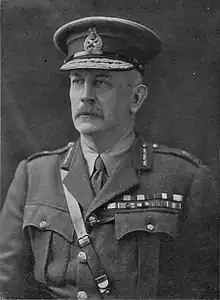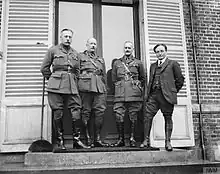George Henry Fowke
Lieutenant General Sir George Henry Fowke KCB, KCMG (10 September 1864 – 8 February 1936) was a British Army officer who served on the staff of the British Expeditionary Force during the First World War.
Sir George Henry Fowke | |
|---|---|
 | |
| Born | 10 September 1864 Halstead, Essex[1] |
| Died | 8 February 1936 (aged 71) Dinard, France |
| Allegiance | |
| Service/ | |
| Years of service | 1884–1922 |
| Rank | Lieutenant General |
| Unit | Royal Engineers |
| Commands held | Engineer-in-Chief, BEF Adjutant-General, BEF |
| Battles/wars | South African War First World War |
| Awards | Knight Commander of the Order of the Bath Knight Commander of the Order of St Michael and St George Mentioned in Despatches |
Biography

Fowke joined the Royal Engineers as a lieutenant on 15 February 1884, and was promoted to captain on 19 July 1892.[2] He saw active service in South Africa during the Second Boer War, where he was present at the Defence of Ladysmith, for which he was mentioned in despatches.[3] During the war he received a brevet promotion to major on 29 November 1900, and was confirmed with the substantive rank of major on 22 February 1901.[4] The war ended in June 1902 with the Peace of Vereeniging, and for his service he received a brevet promotion as lieutenant-colonel on 22 August 1902.[5]
After the end of the war, he stayed in South Africa and was appointed as Director of Public Works in the Transvaal and was a member of the Transvaal Legislative Council from 1902 to 1904.[6] During the Russo-Japanese War he was an observer attached to the Japanese Army in Manchuria, and then lectured on fortifications at the School of Military Engineering.[6] He was appointed the Assistant Adjutant General for the Royal Engineers in 1910, and then the Inspector of the Royal Engineers in 1913.[6]
On the outbreak of the First World War in August 1914, he was appointed to the post of Brigadier-General Royal Engineers in the BEF, the senior engineering advisor.[6] As the war settled into a stalemate it became apparent that the Royal Engineers would play a significant role in trench warfare, and the position was changed to Chief Engineer and then to Engineer-in-Chief in 1915. It was in this position, that he agreed the formation of the Royal Engineer tunnelling companies, after a proposal from John Norton-Griffiths.
In February 1916 he was promoted to hold the post of Adjutant-General of the Expeditionary Force.[6] He held this post until the end of the war, and retired from the Army in 1922.[6]
In addition to his many British decorations and awards, he was also awarded the Army Distinguished Service Medal by the United States, with the citation for the medal reading:
The President of the United States of America, authorized by Act of Congress, July 9, 1918, takes pleasure in presenting the Army Distinguished Service Medal to Lieutenant General George H. Fowke, Royal British Army, for exceptionally meritorious and distinguished service in a position of great responsibility to the Government of the United States, during World War I. While serving as Adjutant General, British Expeditionary Services, General Fowke rendered invaluable service to the American Expeditionary Forces and to the cause in which the United States has been engaged.[7]
References
- IWM, Lives of the First World War
- Hart′s Army list, 1903
- "Mentions in despatches – Army". Archived from the original on 20 August 2009. Retrieved 21 March 2008.
- "No. 27501". The London Gazette. 5 December 1902. p. 8440.
- "No. 27490". The London Gazette. 31 October 1902. p. 6900.
- Liddell Hart Centre for Military Archives
- "Valor awards for George H. Fowke". Military Times.